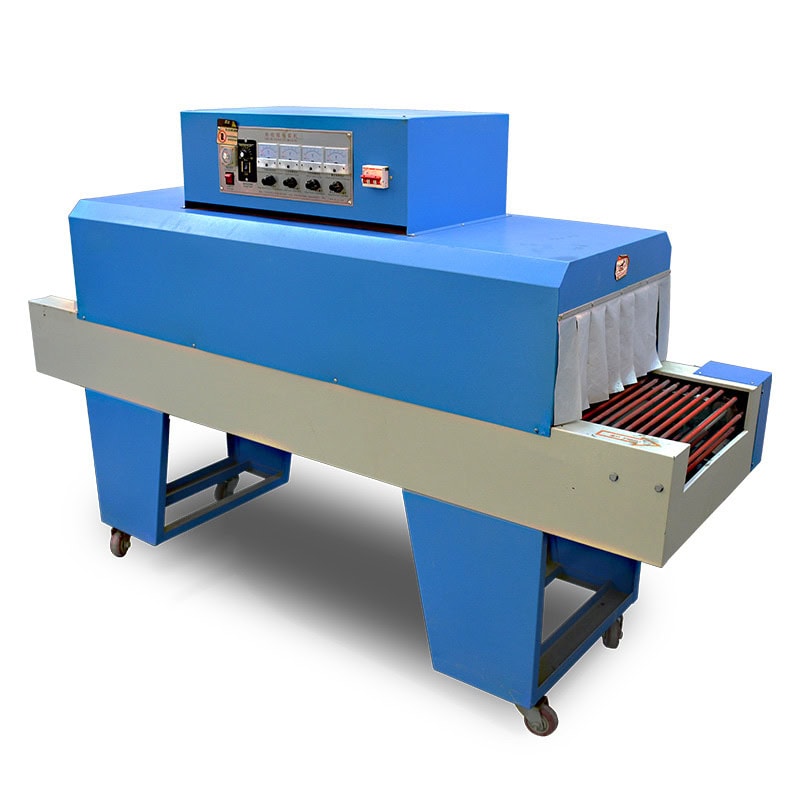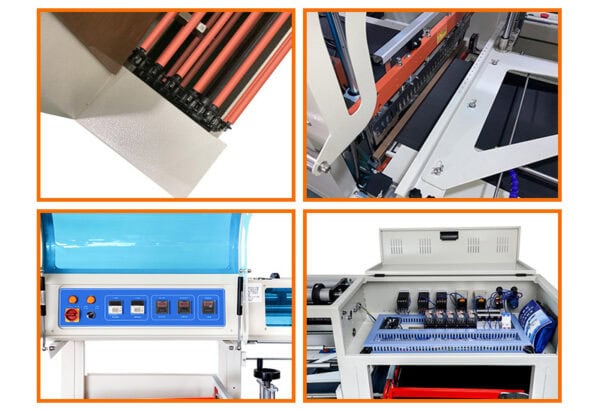Shrink wrapping can be challenging without understanding the machine’s mechanism. Missteps in shrink wrapping lead to poor package integrity, which risks product safety. Here, we explain the process to help you make the best choices for efficient and reliable packaging.
Shrink wrap machines work by applying heat to a polymer-based film, which tightly conforms to a product’s shape. This process involves wrapping, sealing, and heating, ensuring product protection and a snug fit around the item.
Learn about how shrink machines work and why they are vital in modern packaging.
The Simple, Magical Truth of Shrink Wrapping
Here’s the gist: Shrink wrap machines are all about taking a special type of plastic film and adding heat. When the heat kicks in, that film tightens up, wrapping around the product snugly. It’s like a cozy blanket in winter, only this blanket is there to protect and preserve. In a nutshell, that’s the job of a shrink wrap machine—giving products that perfect fit, like a tailor for your favorite book or gadget.

Let’s Get Real: Why Shrink Wrapping Just Works
Shrink wrapping isn’t just about keeping products safe. It’s about presentation, too. Think about a box of cookies wrapped tightly in glossy plastic—doesn’t it just make you want to grab it off the shelf? Or those multi-packs of juice boxes that don’t come flying apart because they’re shrink-wrapped together? Shrink wrap is both practical and, yes, a little bit charming. It’s that invisible touch that gives products a “pick me up” on the shelf, and as a packaging choice, it’s pretty much everywhere.
How Shrink Wrap Machines Do Their Thing
Alright, here’s where the magic happens. Shrink wrapping boils down to three steps:
- Wrapping: First, you cover the product with a loose layer of plastic film.
- Sealing: Next, the film edges are sealed. It’s like you’re wrapping a present.
- Shrinking: And then the magic moment—heat is applied! It could be a heat gun or a shrink tunnel, but as soon as the plastic gets warm, it shrinks right up, forming a tight, clean package around the item.
Now, I remember seeing this process for the first time on a shrink wrap machine at a factory. I was mesmerized. Watching that flimsy plastic turn snug and perfect was like watching someone fit the last puzzle piece into place.

So Many Options: The Different Types of Shrink Wrap Machines
Here’s the thing: not all shrink wrap machines are created equal. Depending on your needs, you might use:
- Manual Machines: Perfect for small jobs, where someone needs to be hands-on, making sure everything’s wrapped just right.
- Semi-Automatic Machines: These let you skip a few steps but still need some supervision. They’re great for medium-sized production runs.
- Automatic Machines: Think of these as the grandmasters of the packaging world. They take care of everything, all on their own, perfect for high-speed operations where humans just can’t keep up.
I’ll admit, I’ve had the most fun with semi-automatics. They’re like the sous-chef of your operation—helping with the heavy lifting but still letting you control the process. It’s satisfying to get in there and see that perfect wrap come together.
Choosing the Right Shrink Wrap Material
Shrink wrap isn’t one-size-fits-all. You’ve got options, and each type of plastic brings its own flair. Here’s a quick rundown:
- Polyolefin (POF): Super clear and durable. Great if you want your product to look polished.
- PVC: Old school, solid choice for non-food items. Not the best for everything but works in a pinch.
- Polyethylene (PE): Strong and thick, perfect for heavier items.
Selecting the right film might sound like a chore, but once you see how different types affect the final look, it’s actually kind of satisfying. It’s like picking the right icing for a cake—small detail, big difference.
Sealing Techniques for a Perfect Wrap
Once you’ve wrapped the item, you want that seal to be just right. Think about it like this: if you don’t have a good seal, the whole thing just looks…well, sloppy. Here are a few ways to get it done:
- L-Seals: Great for smaller items, sealing two sides in an “L” shape.
- Lap Seals: If you’re working with a continuous flow of products (like on a conveyor), these are your best friend.
- Side Seals: Perfect for larger or bulkier items, giving a solid, even finish.
Finding the right seal for the job is half the fun—and seeing that perfect seam when it’s done right? So satisfying.

The Secret Science Behind Shrink Wrapping
Alright, here’s a little science for you. The plastic used in shrink wrap has a unique molecular structure that’s stretched out. When you heat it up, those molecules relax and pull back to their original shape. This is what causes the shrink, and it’s why the plastic tightens up around your product. It’s the same principle as a rubber band snapping back when you let go. Kind of cool, right?
Shrink Wrap’s Many Friends: Real-Life Uses
Shrink wrap shows up in a ton of places. Here are a few ways it’s making life easier (and products safer):
- Food & Beverage: Keeps things fresh and tamper-proof.
- Electronics: Prevents moisture and dust from sneaking in.
- Pharma: Shrink wrap means tamper-evident seals, which is a must for medications.
- Industrial Goods: Think bulk packaging, like labeling machines or big bundles of wires.
If you’re in any of these industries, you know just how much of a difference shrink wrap can make.
Pros and Cons: The Truth About Shrink Wrapping
The Good:
- Affordable: Compared to other packaging, it’s usually pretty budget-friendly.
- Versatile: Works for everything from delicate gadgets to stacks of cans.
- Protective: Shields against dust, moisture, and accidental damage.
The Not-So-Good:
- Heat Sensitivity: Some products don’t do well with heat, so shrink wrapping might not be the best fit.
- Plastic Waste: Let’s be real—there’s a bit of a trade-off when it comes to sustainability.
So, is it perfect? Maybe not. But it gets the job done when you need durable, reliable packaging.
Keeping Your Shrink Wrap Machine Happy
Your shrink wrap machine is like any tool: take care of it, and it’ll take care of you. Here are a few things I’ve learned from experience:
- Clean It Regularly: Dust and debris can mess with the film feed, so a quick wipe-down now and then goes a long way.
- Check the Heating Elements: If the heat isn’t right, you won’t get a good shrink.
- Troubleshoot with Patience: Wrinkles? Check the temperature. Film not tight enough? Adjust the seal.
It might sound a little tedious, but it’s worth it when you see that perfectly shrink-wrapped package come out the other side.
The Bottom Line
Shrink wrap machines are a behind-the-scenes hero in packaging. They keep our products safe, polished, and ready for the shelf. So next time you pick up something wrapped in that snug, glossy plastic, you’ll know the little science and care that went into it.









